
Rhino road trip
A pioneering translocation initiative is helping to secure the future of southern white rhinos in Africa
ALL SEEMS QUIET ON THE ROAD TO BULAWAYO AS we travel across Zimbabwe in the dead of night. At around midnight, our walkie-talkie crackles into life and we hear wildlife manager Colin Wenham’s voice. “There’s noise coming from the crates,” he says. “We need to pull over.” Our convoy of six vehicles and a 20-tonne truck drives slowly into a layby and we park up. It’s late May with winter approaching and under a cloudless sky full of stars, I shiver from the chill in the air. That doesn’t bode well for our cargo.
Two crates the size of horseboxes are side by side on our truck, each housing a southern white rhino on route to their new home. Aiming to avoid the heat of the day, we’d left Malilangwe Wildlife Reserve in south-east Zimbabwe at 8pm. Some 750km and 16 hours later, our journey would end at the new Imvelo Ngamo Wildlife Sanctuary bordering Hwange National Park in the north-west.

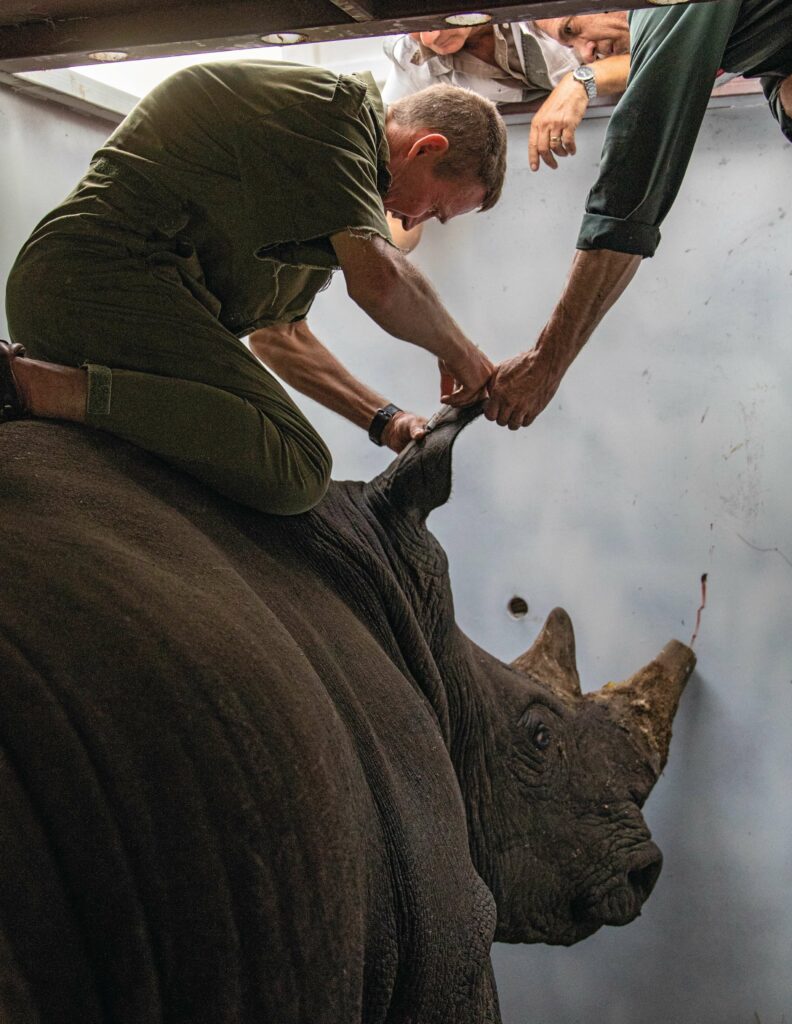
Translocating such rare cargo is nothing new for the expert team at Malilangwe. Rhinos were initially reintroduced to this former cattle ranch in the late 1990s and its conservation programme has been hugely successful, having the perfect habitat for both black and white rhinos, extensive security measures and comprehensive monitoring. The reserve now helps set up viable breeding populations in secure locations around Zimbabwe and beyond.
On this occasion, rhinos #204 and #803 are leaving Malilangwe to do their bit for their species’ survival. But rather than moving to a government-run national park or a privately owned reserve, these two bulls will be going somewhere very special. Their pioneering new home is the first in Zimbabwe where white rhinos will live in a sanctuary on communal lands, with the communities themselves as custodians.
The one-mile square sanctuary in the Tsholotsho region is the pilot project for the innovative Community Rhino Conservation Initiative (CRCI), founded by former ranger Mark Butcher, now managing director of Imvelo Safari Lodges, with four properties around Hwange. Butcher remembers the 1970s and 80s when Zimbabwe’s largest national park was home to some 120 white rhinos. “They were part of the scenery on the sand country of southern Hwange,” he said. “But we lost them all to poaching, and it’s never been the same since.”
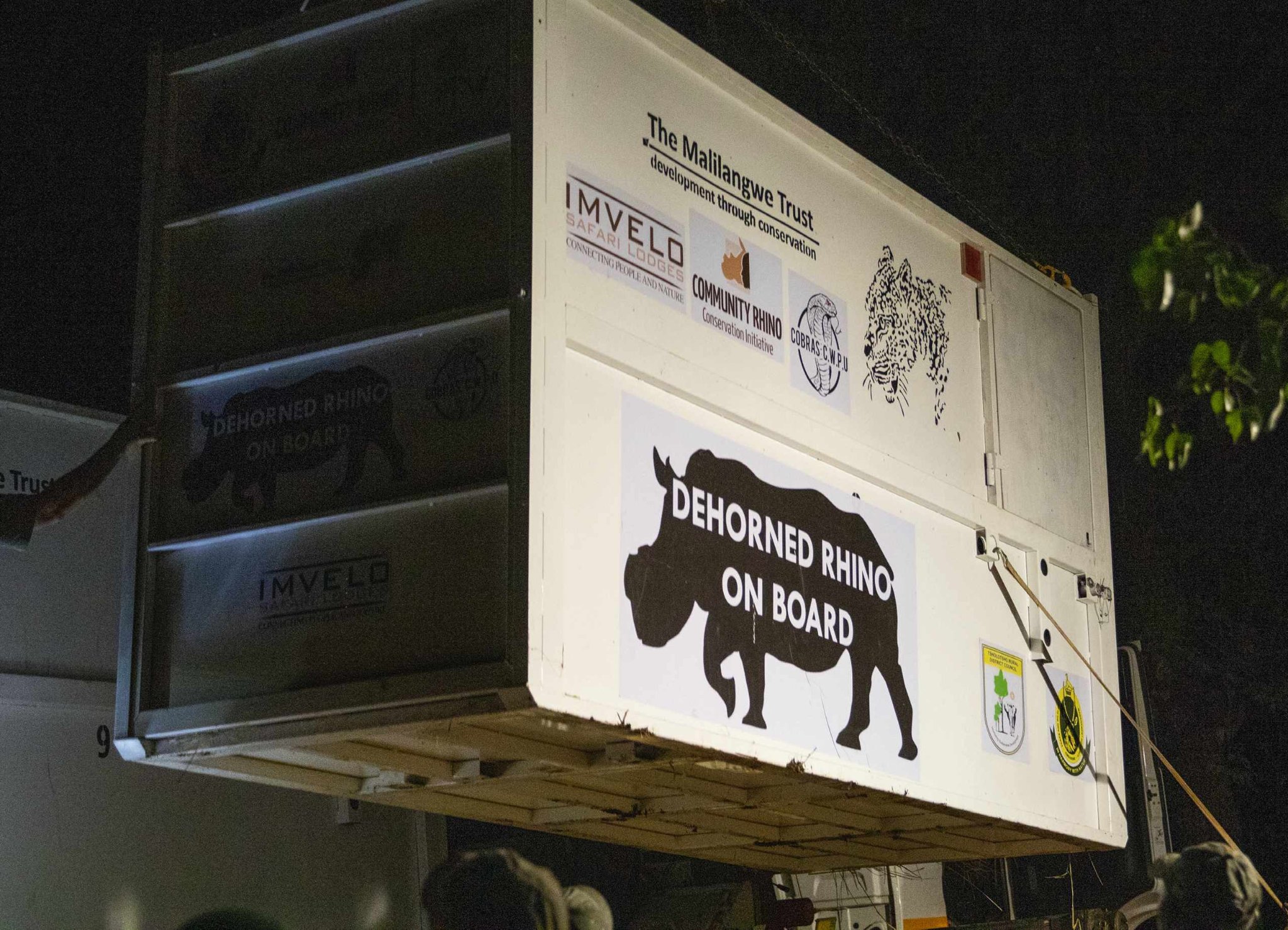
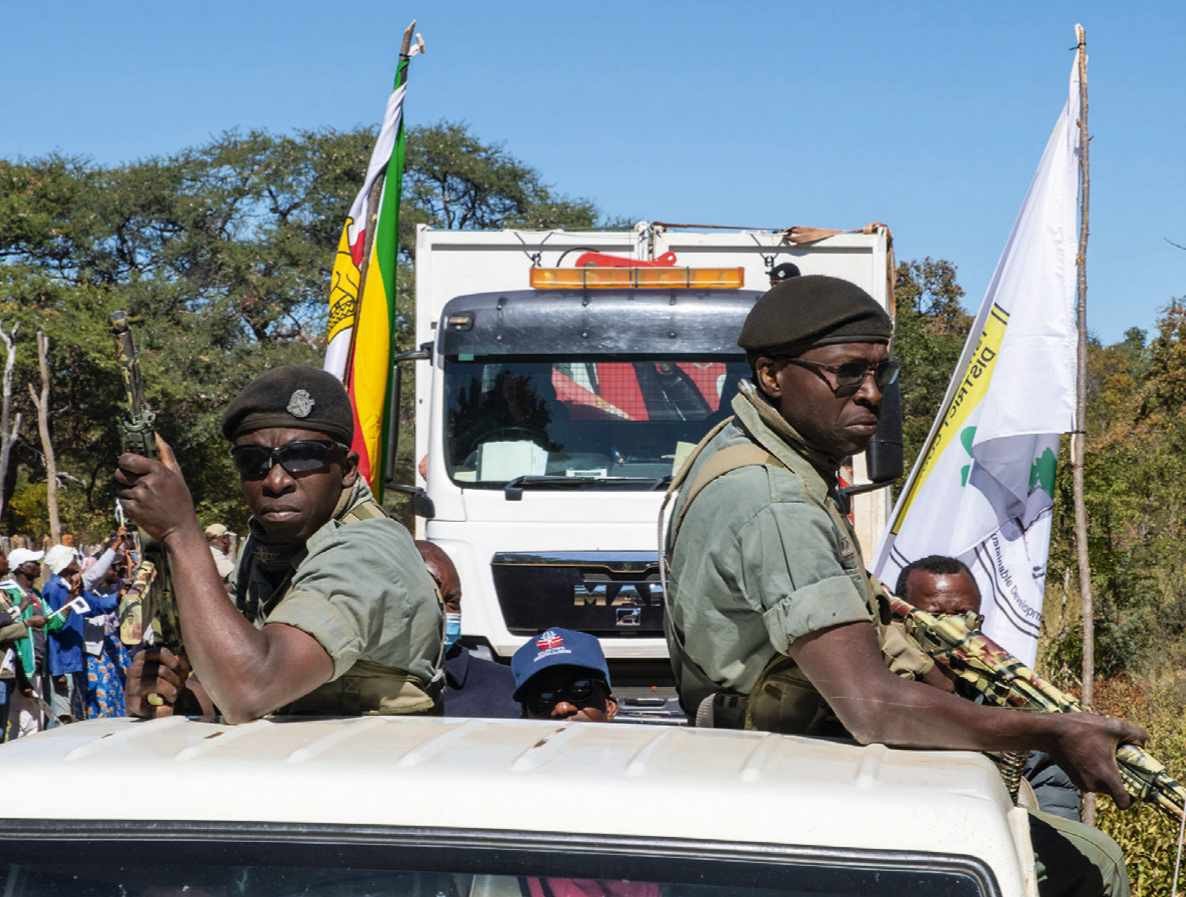
With a lifespan of 40-50 years, our two rhinos, aged seven and eight, are in their prime and are unrelated – both important factors for future breeding. They’ve been carefully selected by ecologist Sarah Clegg, who has been monitoring every individual in Malilangwe using a system of unique ear notches to aid identification, collating rare data on their backgrounds and behaviours for more than 20 years. Two weeks earlier, they were captured from the reserve’s plains and moved to a holding boma (enclosure) for their translocation. “Unusually for unrelated bulls, these two are always together,” she tells me. “Their special bond will make adjusting to their new home much easier.”
At 4pm, Malilangwe’s team, including the reserve’s wildlife manager Colin Wenham, specialist vets, ecologists and scouts all gather outside the fenced boma to load the rhinos into their crates. “There has to be absolute silence because the rhinos will be stressed,” wildlife veterinarian Chris Foggin instructs onlookers. “Don’t get excited, don’t make a noise and do as you’re told.”
The team works quietly, speaking in whispers or simply through hand signals, as Colin darts rhino #204, weighing about 1,500kg, through a gap in the fence. The bright pink tuft protruding from the bull’s side stands out vividly against his grey bulk.
“It’s a difficult balancing act getting the exact amount of drugs for the body size,” Sarah explains. “We need to have the rhino sedated so we can control his movements but not so heavily immobilised that we can’t move him.”
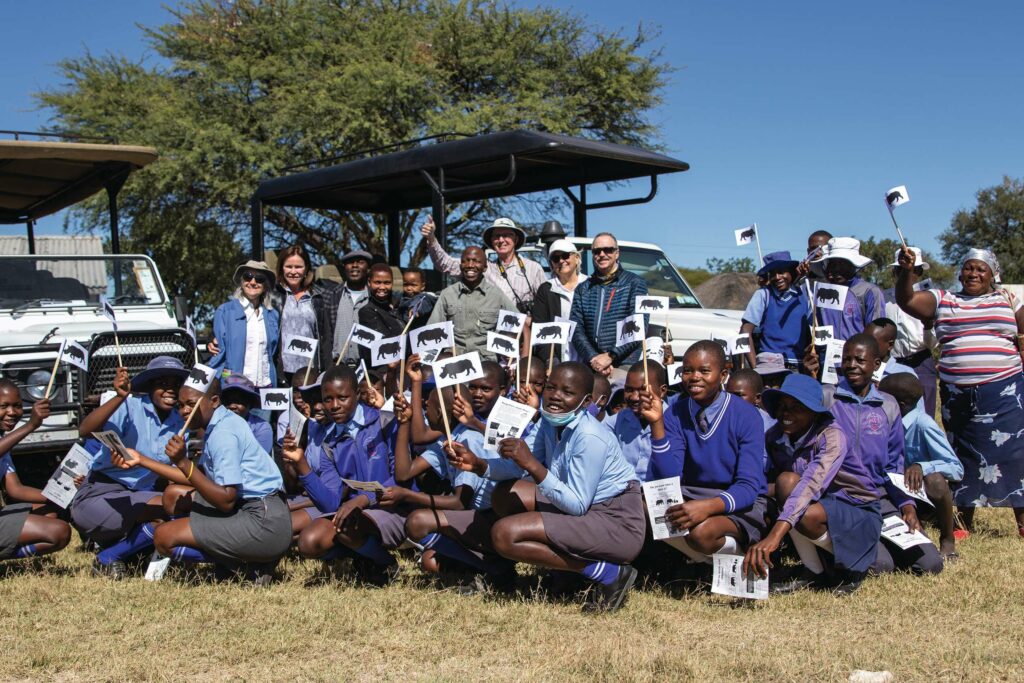
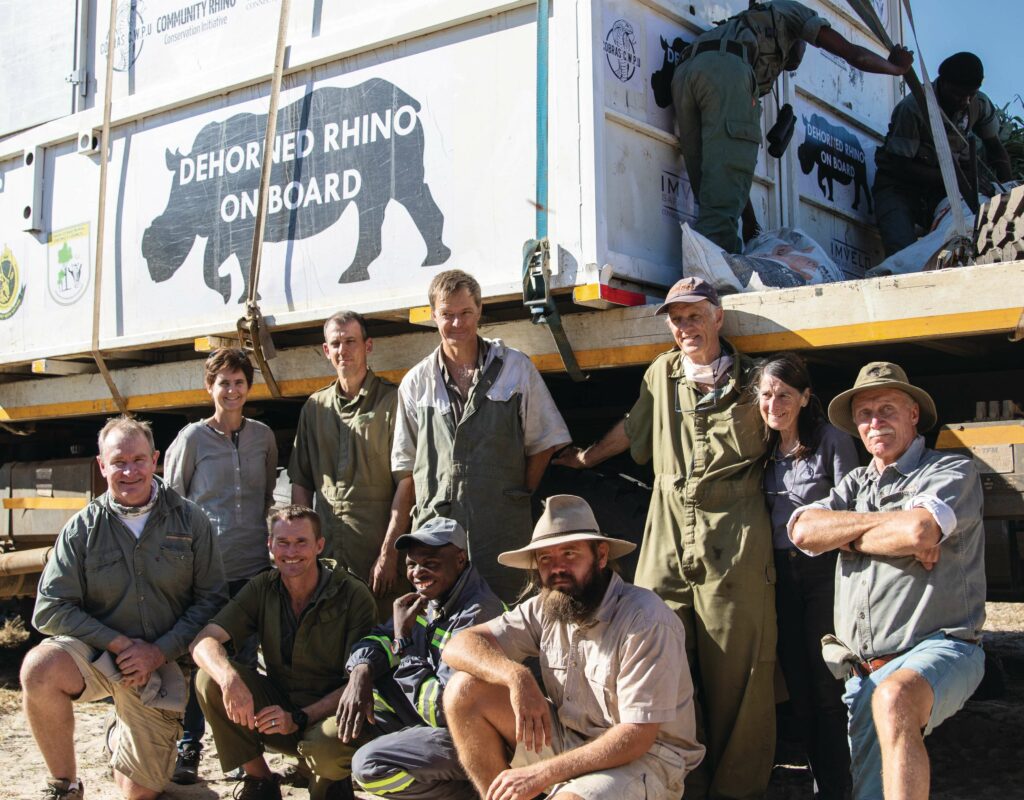
Once the drugs have kicked in, Malilangwe’s scouts walk our drowsy bull into the crate, guiding him with ropes. Leaving him groggy but still on his feet, they move on to load rhino #803.
This time, the drugs are more complicated. After having the immobilising dart, our big bull, weighing some 1,800kg, lies down in the boma and not even the cattle prod will get him back on his feet. They give him reversal drugs, spray water in his ears, sway his body from side to side and give more drugs. As darkness falls, with thunder rumbling and torrential rain coming down, he eventually stirs and the team pull him into the crate using ropes and brute strength. Their concern and relief are palpable.
Throughout the loadings, Sarah has been clutching her clipboard, recording the drugs administered and the rhinos’ reactions to them. I ask her how she’s feeling. “Nervous, tense, all those emotions,” she replies. “We’ve done all we can but there’s always potential for things to go wrong.”
With the crates carefully craned on to the truck, we eventually leave nearly two hours later than planned. Our route takes us along tarred roads through the towns of Chiredzi and Triangle, surrounded by sugarcane plantations, to the mining town of Zvishavane before reaching Bulawayo, Zimbabwe’s second city. It’s just a regular Saturday night with people out and about, but their heads turn in surprise as our truck drives past with stickers reading “Dehorned rhinos on board”. On the long stretches between towns, we travel at around 70kph. Thankfully, there are few cars on the road, making it easier to monitor our pachyderm passengers.
Our first stop is just half an hour in, with Bruce Clegg, Sarah’s husband and fellow ecologist, and Colin climbing inside the crates through roof hatches to check the rhinos’ temperatures and positions.
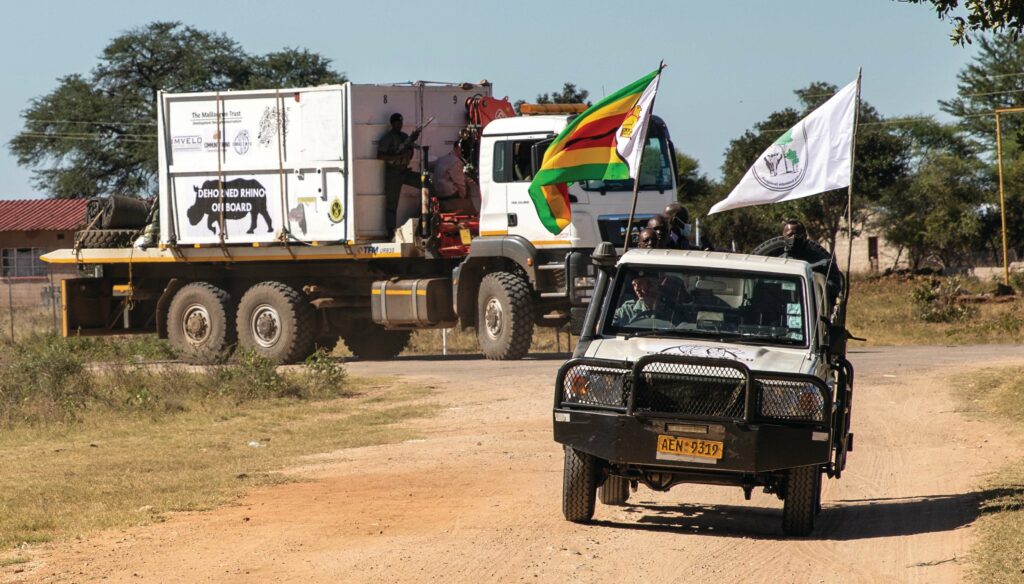
“Heads turn in surprise as our truck drives past with stickers reading ‘Dehorned rhinos on board’”
Aside from the routine on-the-road risks – lorries coming towards us with only one headlight, cyclists with no lights at all, random people and animals wandering around in the dark – the rhinos themselves face potentially fatal health risks on translocations. Hypothermia can occur if the temperature drops too low. “If it gets too cold, we’ll just stop the vehicles and park under trees to let the rhinos warm up,” Sarah explains. “The wind-chill is the problem and metal crates don’t insulate well.”
The immobilising drugs can cause the rhinos’ body temperatures to rise to dangerous levels. “Their normal body temperature is similar to a human’s, but if it gets above 40°C, we’ll be spraying water and sometimes fanning the rhinos. In really bad cases, we’ve used the helicopter to fan the animal from above.”
The drugs can also cause ataxia (a loss of coordination) and severe neck injuries should the rhinos push into the crates. If they lie down or fall over, depending on their position, they can suffer cramps, circulation problems and critical breathing difficulties. Hence we stop at least hourly, unless noises from the crates dictate otherwise, to check the rhinos and administer drugs if necessary, striving to get that perfect balance between sedatives and reversals, between being woozy and wide awake. The risks to the rhinos play on the minds of the crew as we drive, but after years of working together, their worries and tensions are masked by their calmness, professionalism and their mutual trust and respect.
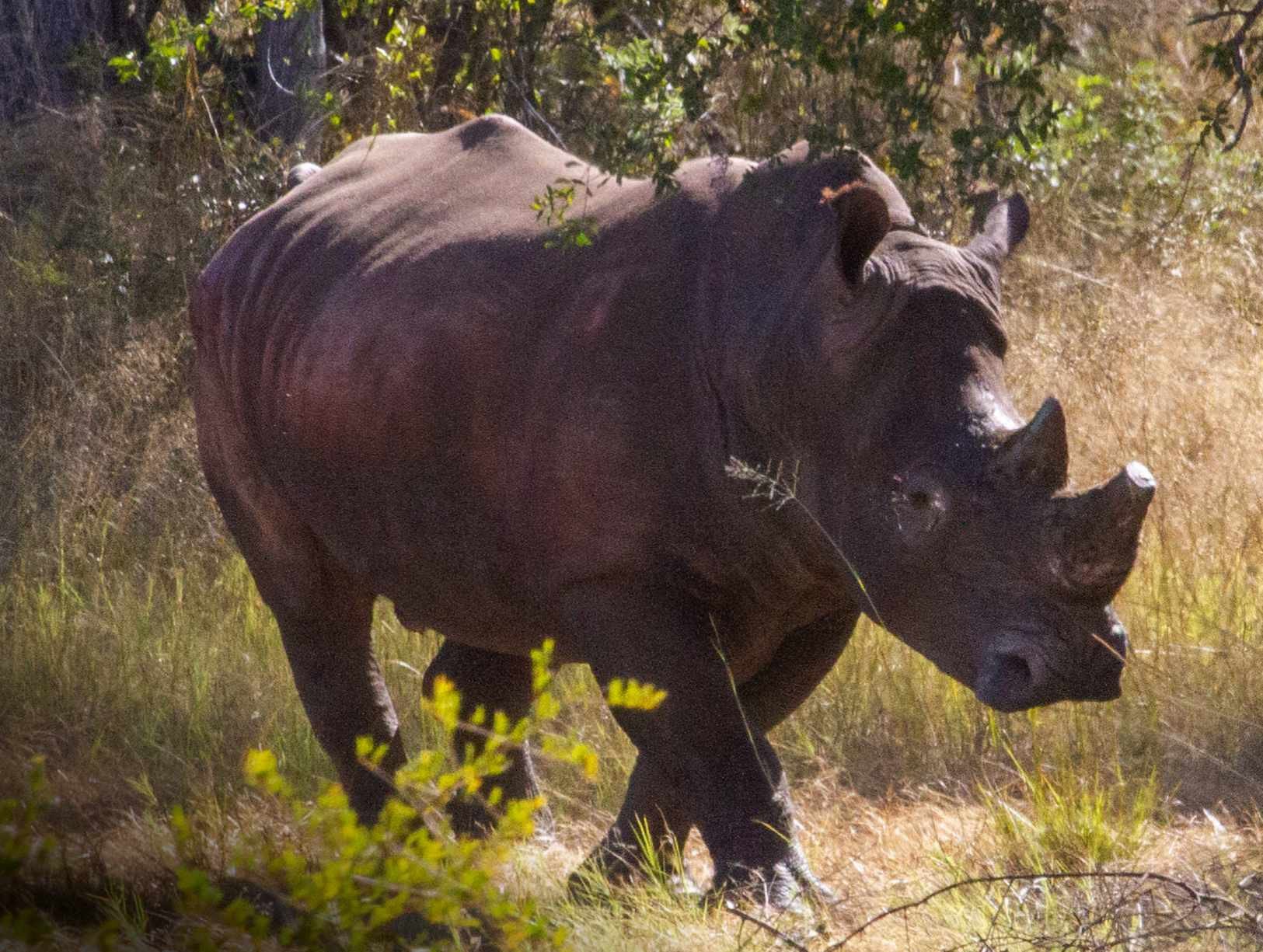
Poor rhino #204 is having a rough ride. Sometimes lively, sometimes groggy, he hasn’t always responded as expected to the cocktail of drugs he’s been given; finding that all-important balance has proved tricky. Added to that, even though his crate is covered with hay for him to eat, the downpour during loading has made the floor damp and slippery.
When we pull in at midnight, the verge isn’t completely level, causing the small rhino to fall: Colin finds him upside-down with his legs flailing. Remaining calm despite serious concerns, he and Bruce watch with relief as the rhino rights himself. Under that cold starlit sky, scouts dig up soil from the roadside to scatter on his floor, hoping it will give him more traction. The next couple of hours are thankfully uneventful.
Dawn is breaking as we drive through Bulawayo, some nine hours into our journey. Heralding a special moment, Mark Butcher’s excited voice comes over the radio: “We’ve just entered Matabeleland North,” he announces. “And these are the first rhinos to enter this province in nearly 20 years.”

By now, the temperature is a chilly 1°C and the rhinos are feeling it. The big bull starts banging his crate, agitated by the draught from the side hatch. It opens and flaps in the wind. They stop and seal it with duct tape, only for him to repeat his actions minutes later on the roof hatch. Chris gives him drugs to calm him but when we turn off the highway on to a gravel road near Lupane, he’s banging the roof once more.
Here we meet the scouts of CRCI’s Cobras Community Wildlife Protection Unit. Dressed immaculately in camouflage, with firearms in hand and flags flying high, they take on responsibility for the security of the bulls with an air of quiet celebration. That continues as we drive on the sandy roads around the Tsholotsho communal lands where the chief of the Ndebele people and other VIPs, village headmen, district councillors, national parks officials and police have gathered to welcome the rhinos, joining the convoy that is now some 20 vehicles long. Teachers and school children silently wave their rhino flags so as not to stress the animals, but their excitement shines through their smiles. And at 12.42pm precisely, we drive through the gates of Imvelo Ngamo Wildlife Sanctuary: the rhinos are home.
With the crates craned off the truck beside their new 2ha boma inside the sanctuary, the rhinos’ hefty backsides are facing the entrance, ensuring they walk out backwards. “We don’t want them to charge or have an explosive exit,” Sarah explains. “We want them to come out slowly and safely.”
Surrounded by silence, the big bull ventures out first, reversing quietly before walking away from the gate. He’s closely followed by the smaller rhino who, in contrast, rushes around angrily, shaking his head. On seeing his friend nearby, he calms and wanders up to join him.
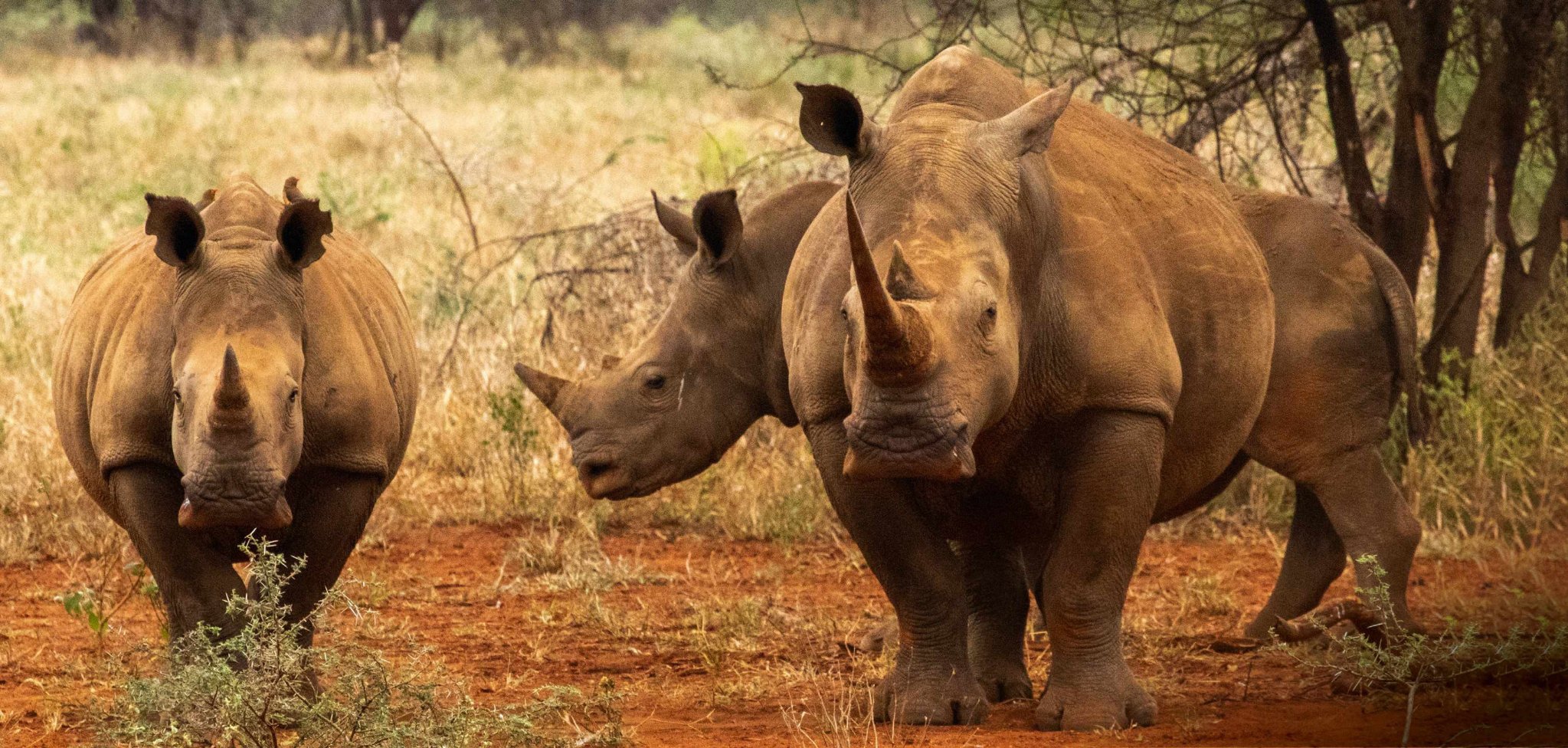
The Malilangwe and Imvelo teams can breathe a collective sigh of relief; their smiles speak volumes. “You never know how things are going to end up on these translocations,” Colin says. “Right from the start until the moment you finish, your heart is in your throat.”
“Each translocation is a potential catastrophe for the animals,” Sarah adds, “but they absolutely have to happen. At Malilangwe, we have a responsibility to contribute to the global herd of rhinos. Humans now take up so much land, we form a natural barrier to expansion of their habitat. We need these new habitats, because without them rhinos simply cannot survive.”
Together, our rhinos wander off to explore. They’ll stay in the boma until they’ve adapted to their new environment, when Chris can give the all-clear for their release into the sanctuary. All being well, they’ll eventually be joined by more rhinos and become the founding fathers of Hwange’s new herd.
IN NUMBERS
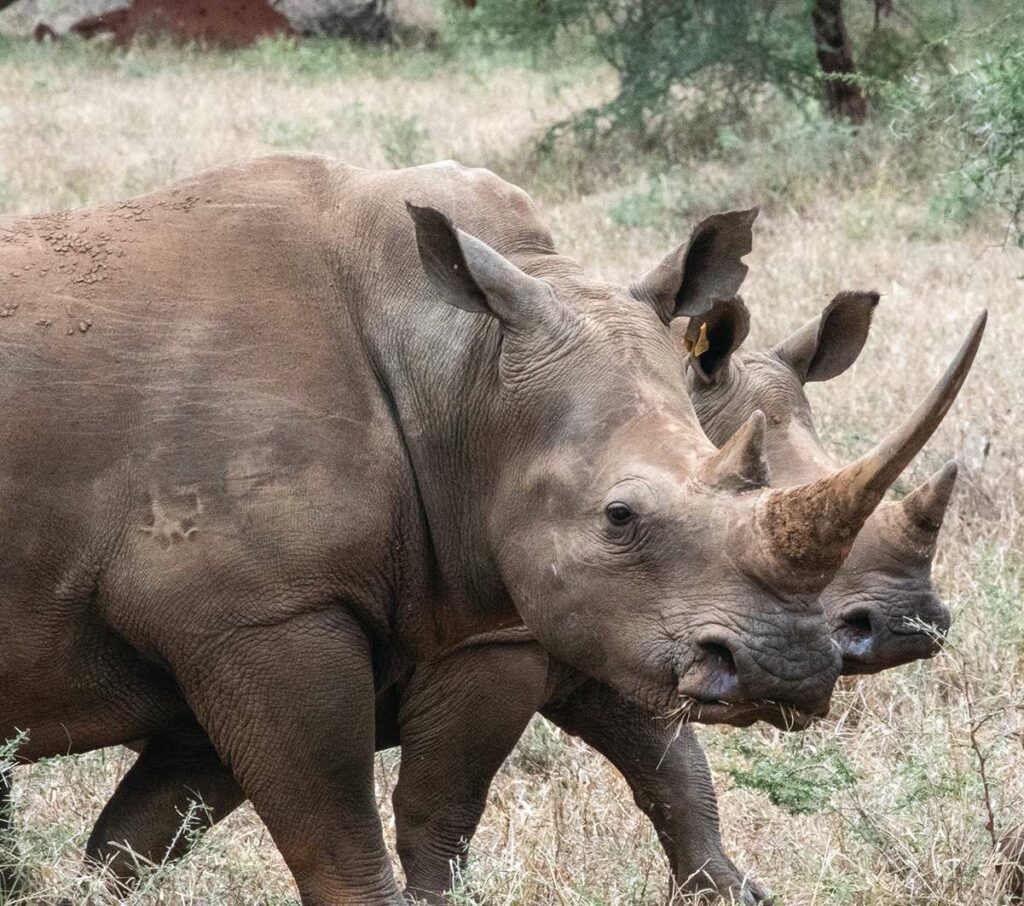
18,000
The number of white rhinos (alongside 5,600 black rhinos) thought to survive in Africa today, according to Save the Rhino. This figure is down from an estimated 21,000 in 2015.
60,000
The maximum cost in US dollars for 1kg of rhino horn in the illegal wildlife trade. Poaching of both black and white rhinos is back with a vengeance, particularly in South Africa and Botswana, after dropping off substantially during the Covid-19 lockdown.
1,000
The estimated number of rhinos in Zimbabwe in 2021, making it the fourth largest population on the continent after South Africa, Namibia and Kenya.
The bigger picture
A ground-breaking community-centered conservation project
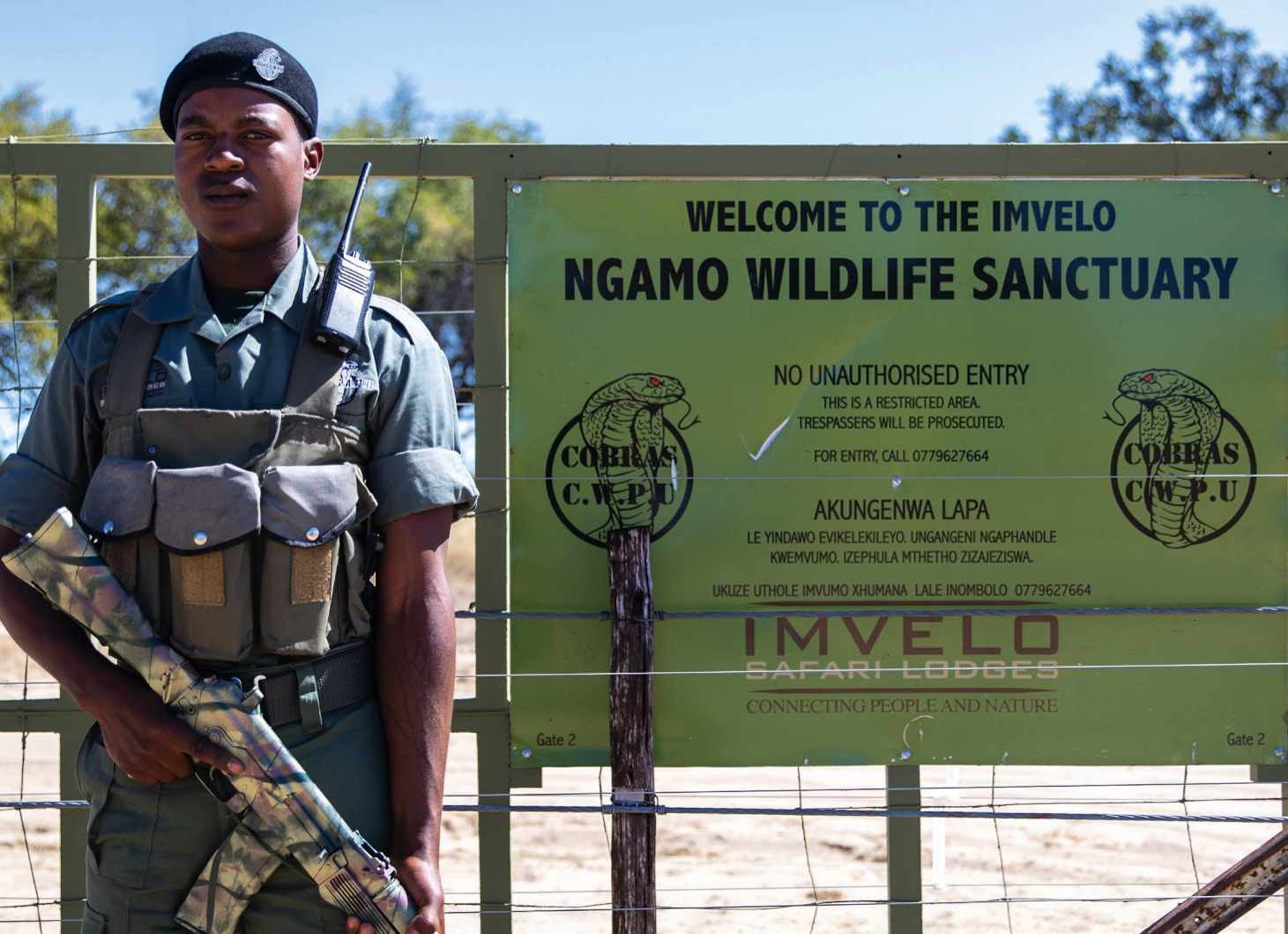
THE REINTRODUCTION OF TWO rhinos to Imvelo Ngamo Wildlife Sanctuary marks the first step in an ambitious and exciting journey for The Community Rhino Conservation Initiative (CRCI). The plan is to have a patchwork of small sanctuaries around the Tsholotsho Communal Lands that will eventually form one much larger conservancy on the southern borders of Hwange National Park that would be home to a breeding herd of 30-50 rhinos. For the first time, CRCI will create a fenced buffer zone to reduce human-wildlife conflict. Farmers will voluntarily give up cattle-grazing land, but will benefit from tourist income, sanctuary entry fees and employment. None of this would be possible without the consent of the communities. Over the years, they’ve received healthcare and education benefits from tourism operators, but giving up land is something else. Mark Butcher is the force behind CRCI, but many others, including councillors and village headmen, have played roles in logistics and securing community buy-in.
Today, the commitment and sense of ownership from the communities towards ‘their’ two bulls bodes well for the arrival of females planned for the next mini-sanctuary. Find out more: hwangecommunityrhino.com

ABOUT THE AUTHOR
Sue Watt is a freelance travel writer and travelled to Zimbabwe with thanks to The Luxury Safari Company. See more of her work at suewatt.co.uk.